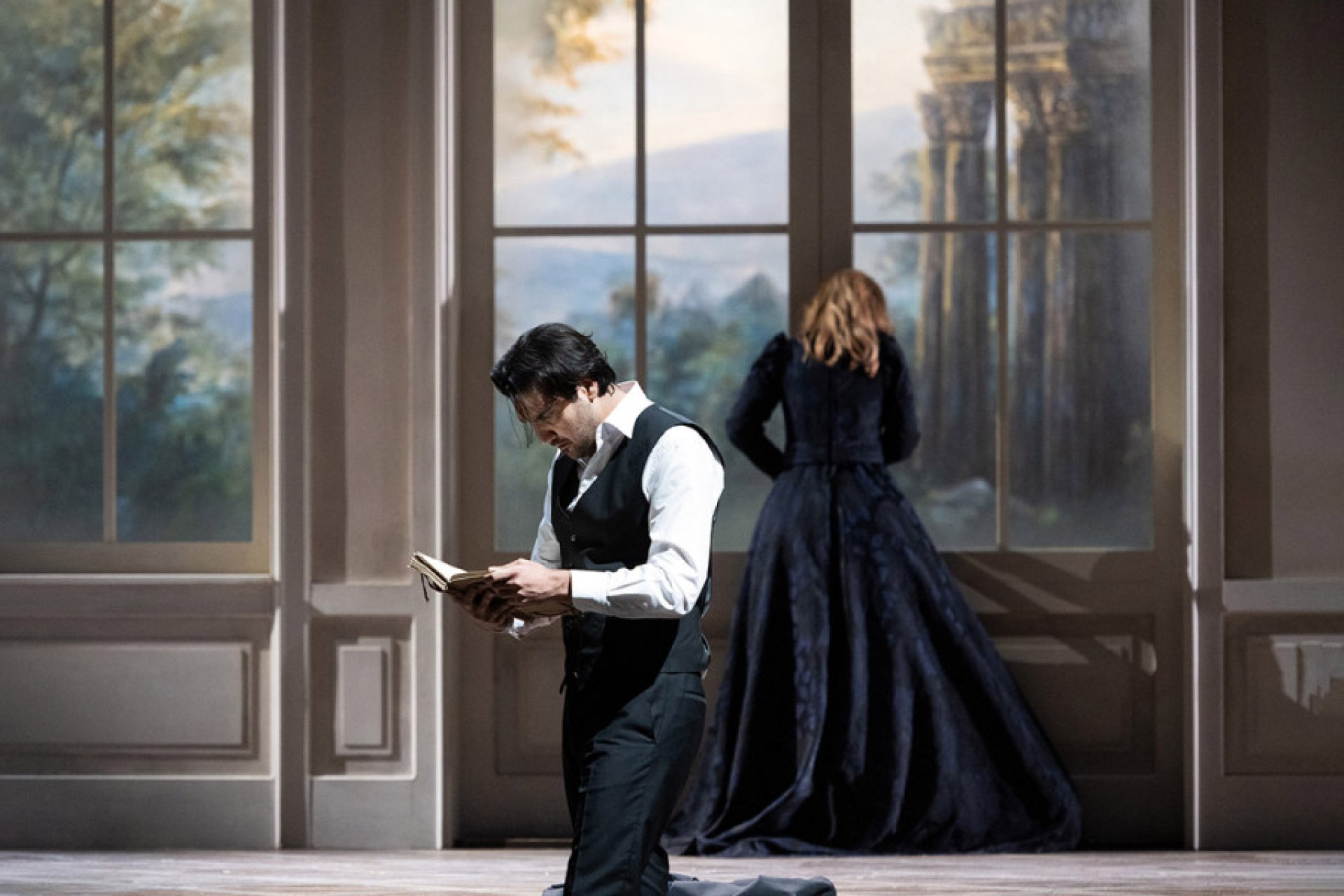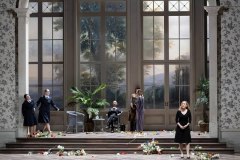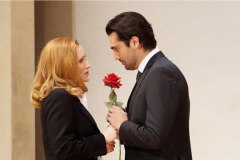Francesca da Rimini
Mo | Tu | We | Th | Fr | Sa | Su |
Francesca da Rimini
Riccardo Zandonai [1883 – 1944]
Tragedia in four acts
Libretto by Tito Ricordi based on Gabriele D’Annunzio's poem
First performed on 19th February, 1914 at the Teatro Regio in Turin
Digital premiere in streaming at Deutsche Oper Berlin on 14th March, 2021
Audience premiere on 19th May, 2023
approx. 3 hrs / one interval
In Italian language with German and English surtitles
Pre-performance lecture (in German): 45 minutes prior to each performance
About the performance
On the work
He was touted as the new star in Italy’s operatic firmament around 1910. Publisher Tito Ricordi had big plans for the young Riccardo Zandonai and was sparing no cost to achieve the same triumphs with him as Giulio Ricordi had done a generation earlier with the young Puccini. For a huge fee, Ricordi secured the rights to a scandalous contemporary play - Gabriele D’Annunzio’s 5-act drama “Francesca da Rimini” – which had created a stir with its bloody civil-war scenes, cruel passions and adulterous couple. D’Annunzio’s fin-de-siècle-esque “poem of blood and lust” was all the rage in artist circles. The 31-year-old Riccardo Zandonai spied his chance to pen a florid opera of grandiose scale in a musical language fusing a raft of styles and epochs. And sure enough, Zandonai ploughs his individual European furrow of musical theatre, encompassing Italian bel canto, hints of Renaissance madrigals, gritty verismo, pre-Fascist marches, Wagner’s TRISTAN as a point of reference and a French Impressionism à la Debussy.
The story revolves around three brothers in love with the same woman. Francesca da Polenta, from Ravenna, is being forced into a marriage of convenience to a scion of the Malatesta family in Rimini. The intended groom, Giovanni, is old and unattractive and reluctant to risk rejection by wooing the maid face-to-face, so he sends his handsome brother Paolo as a front, whereupon the unwitting Francesca falls in love with wrong man and signs the marriage contract. Time passes and Francesca, living in unhappy wedlock with Giovanni, embarks on a passionate affair with Paolo. She is presented as both victim and perpetrator, as a lover with a death wish and also a powerful seductress, whom the third brother falls for, too. The facets of this complex and contradictory character run the gamut of emotions “between roses and violent fantasies” (Christof Loy), between total devotion and destructive erotic forces in a cruel and cunning world controlled by men.
Synopsis
The story takes place in Ravenna and Rimini.
Francesca, daughter of Guido I da Polenta, for state reasons, is to be married to Giovanni, known as Gianciotto, the malformed son of Malatesta da Verucchio. But as Francesca would certainly refuse to marry the lame and deformed Gianciotto, she is introduced in the first act, by means of a well-laid plot, to his handsome younger brother, Paolo, known as Il bello. Under the impression that Paolo is her destined bridegroom, Francesca falls deeply in love with him at first sight; he also falls passionately in love with her, although they do not exchange a single word.
The next act takes place on the platform of a tower of the Malatesti, while a battle rages between the Guelphs and Ghibellines. Francesca, now married to Gianciotto, meets Paolo and reproaches him for the fraud practised on her. He begs forgiveness and reveals his intense passion for her. Gianciotto brings the news of Paolo's election as Captain of the People and Commune of Florence. Paolo departs for Florence.
In the third act Francesca, in her luxurious apartment, is reading the story of Lancelot and Guinevere to her women. They then dance and sing in celebration of the advent of Spring, until, on a whispered word from her slave, Francesca dismisses them. Paolo, sick with longing for her, has returned from Florence. He enters; they continue reading the story of Guinevere together, until, no longer in control of their feelings, they let their lips meet in a long kiss.
In the fourth act, Malatestino, Gianciotto's youngest brother, who himself lusts for Francesca, has discovered her secret meetings with Paolo. After Francesca refuses to give in to his sexual advances, Malatestino betrays Francesca and Paolo to Gianciotto, who determines to find out the truth for himself. Accordingly, Gianciotto lies in wait outside Francesca's door, and surprising her and Paolo together at early dawn, he slays them both.
Program and cast
Conductor: Iván López-Reynoso
Stage Director: Christof Loy
Set design: Johannes Leiacker
Costume design: Klaus Bruns
Light design: Olaf Winter
Chorus Director: Jeremy Bines
Dramaturge: Dorothea Hartmann
Francesca: Sara Jakubiak
Samaritana: Maria Vasilevskaya
Ostasio: Philipp Jekal
Giovanni lo Sciancato, named Gianciotto: Ivan Inverardi
Paolo il Bello: Rodrigo Porras Garulo
Malatestino dall’Occhio: Thomas Cilluffo
Biancofiore: Meechot Marrero
Garsenda: Hye-Young Moon
Altichiara: Arianna Manganello
Adonella: Martina Baroni
Smaragdi: Lucy Baker
Ser Toldo Berardengo: Michael Dimovski
Il Giullare: Dean Murphy
Il Balestriere: Michael Dimovski
Il Torrigiano: Artur Garbas
Il Prigioniero: Michael Dimovski
Actors: Jan Gerrit Brüggemann
Actors: Farouk El-Khalili
Actors: Hanno Jusek
Actors: Marcus Mundus
Actors: Emiliano Passaro
Actors: Andrea Spartà
Actors: Koray Tuna
Actors: Benjamin Werth
Actors: Maximilian Reisinger
Actors: Nicolas Franciscus
Actors: Kay Bretschneider
Actors: Paul Krügener
Actors: Lukas Lehner
Actors: Cristiano Afferi
Actors: Pablo Nina Toculescu
Chorus: Chor der Deutschen Oper Berlin
Orchestra: Orchester der Deutschen Oper Berlin
Deutsche Oper Berlin
The Deutsche Oper Berlin is an opera company located in the Charlottenburg district of Berlin, Germany. The resident building is the country's second largest opera house and also home to the Berlin State Ballet.
The company's history goes back to the Deutsches Opernhaus built by the then independent city of Charlottenburg—the "richest town of Prussia"—according to plans designed by Heinrich Seeling from 1911. It opened on November 7, 1912 with a performance of Beethoven's Fidelio, conducted by Ignatz Waghalter. After the incorporation of Charlottenburg by the 1920 Greater Berlin Act, the name of the resident building was changed to Städtische Oper (Municipal Opera) in 1925.
Deutsches Opernhaus, 1912
With the Nazi Machtergreifung in 1933, the opera was under control of the Reich Ministry of Public Enlightenment and Propaganda. Minister Joseph Goebbels had the name changed back to Deutsches Opernhaus, competing with the Berlin State Opera in Mitte controlled by his rival, the Prussian minister-president Hermann Göring. In 1935, the building was remodeled by Paul Baumgarten and the seating reduced from 2300 to 2098. Carl Ebert, the pre-World War II general manager, chose to emigrate from Germany rather than endorse the Nazi view of music, and went on to co-found the Glyndebourne opera festival in England. He was replaced by Max von Schillings, who acceded to enact works of "unalloyed German character". Several artists, like the conductor Fritz Stiedry or the singer Alexander Kipnis followed Ebert into emigration. The opera house was destroyed by a RAF air raid on 23 November 1943. Performances continued at the Admiralspalast in Mitte until 1945. Ebert returned as general manager after the war.
After the war, the company in what was now West Berlin used the nearby building of the Theater des Westens until the opera house was rebuilt. The sober design by Fritz Bornemann was completed on 24 September 1961. The opening production was Mozart's Don Giovanni. The new building opened with the current name.

 EN
EN DE
DE IT
IT FR
FR ES
ES RU
RU JP
JP RO
RO
 Seating plan
Seating plan 


